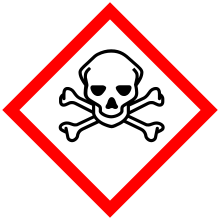Warning label
This article has multiple issues. Please help improve it or discuss these issues on the talk page. (Learn how and when to remove these messages)
|



A warning label is a label attached to a product, or contained in a product's instruction manual, warning the user about risks associated with its use, and may include restrictions by the manufacturer or seller on certain uses.[1]
Some of them are legal requirements (such as health warnings on tobacco products). Most of them are placed to limit civil liability in lawsuits against the item's manufacturer or seller (see product liability).[2][3] That sometimes results in labels which for some people seem to state the obvious.
Lack of a warning label can become an informational defect, which is a type of product defect.[4]
Warning labels are found on various product packagings, such as chemicals (flammable, pesticide, poisons, etc.), batteries, tobacco, alcohol and other unhealthy foods.
Regulation by country
[edit]Chile
[edit]European Economic Area
[edit]In the European Economic Area, a product containing hazardous mixtures must have a unique formula identifier (UFI) code. This is not a warning label per se, but a code that helps poison control centres identify the exact formula of a hazardous product.
Mexico
[edit]United States
[edit]In the United States, warning labels have been instituted under a number of different government organizations. For instance, the Federal Food, Drug, and Cosmetic Act of 1938.[5][6] Cigarettes were not required to have warning labels in the United States until Congress passed the Federal Cigarette Labeling and Advertising Act (FCLAA) in 1965.[7]
Other organizations that create label standards in the US — the Occupational Safety and Health Administration (OSHA) and American National Standards Institute (ANSI) — govern their use. The US organizations pull from international organizations such as the Globally Harmonized System of Classification and Labelling of Chemicals and the International Standards Organization.
Chemical hazard level warning labels
[edit]In the United States[8] or elsewhere, the terms Danger, Warning and Caution are regulated by the Globally Harmonized System of Classification and Labelling of Chemicals (GHS) ANSI Z535. Graphic symbols are regulated by ISO 7010.
| Term | Hazard | Meaning | Usage |
|---|---|---|---|
| Danger! | Highest level | Indicates severe injury or death certain to occur if not avoided. | Reserved for the most severe situations, often accompanied by symbols or pictograms that are universally recognized to quickly convey the risks involved even if the language is not recognized by the viewer. |
| Warning! | Medium level | There is a potential hazard that could result in serious injury or death but is less immediate or severe or probable than those marked with "Danger." | Signals a need for caution and awareness of the potential risks, and, like "Danger," is often paired with symbols to facilitate quick recognition. |
| Caution! | Lowest level | There is a potential hazard that could result in minor or moderate injury, or there is a risk of property damage. | Used in situations where the risks do not typically result in serious injury or death but where attention and care are still required. It advises individuals to proceed with caution to prevent accidents. |
See also
[edit]- Alcohol packaging warning messages
- California Proposition 65 (1986)
- Black box warnings mandated by the US Food and Drug Administration
- Globally Harmonized System of Classification and Labelling of Chemicals
- Tobacco packaging warning messages
- Hazard symbol
- List of food labeling regulations
- Nutri-Score
References
[edit]- ^ Wogalter, Michael S. (2006). "Introduction". In Wogalter, Michael S. (ed.). Handbook of warnings (PDF). Mahwah, New Jersey: Lawrence Erlbaum Associates. ISBN 978-0-8058-4724-6.
- ^ Egilman, D. & Bohme, S. R. (2006). "Purposes and Scope of Warnings". In Wogalter, Michael S. (ed.). Handbook of warnings (PDF). Mahwah, New Jersey: Lawrence Erlbaum Associates. ISBN 978-0-8058-4724-6.
- ^ Khoury, Clarke E. (1989). "Warning Labels May Be Hazardous to Your Health: Common-Law and Statutory Responses to Alcoholic Beverage Manufacturers' Duty to Warn". Cornell Law Review. 75: 158–188.
- ^ "What Are Different Types of Product Defects and How Do they Affect Your Claim?". Retrieved 16 November 2024.
- ^ Federal Food, Drug, & Cosmetic Act, Pub. L. No. 75-717, 52 Stat. 1040 (1938) (codified as amended at 21 U.S.C. §§ 301-99 (2006))
- ^ Carlson, Peter (6 November 2006). "Hey, the labels are kind of stupid, but don't say they didn't try to warn you". The Seattle Times. Retrieved February 23, 2008.
- ^ Federal Cigarette Labeling and Advertising Act, Pub. L. No. 89-92, 79 Stat. 282 (1965) (codified as amended at 15 U.S.C. §§ 1331-40 (1970)).
- ^ Rys, John Van; Meyer, Verne; Sebranek, Patrick (2006). The Business Writer. Houghton Mifflin Company. p. 567. ISBN 978-0-618-37087-0.
